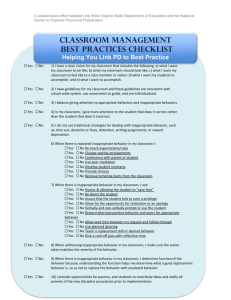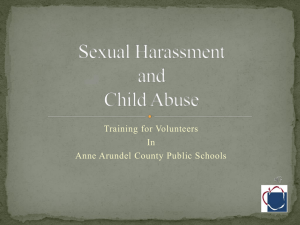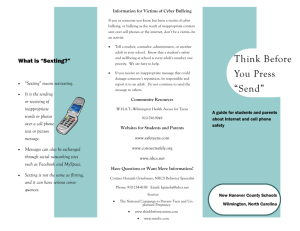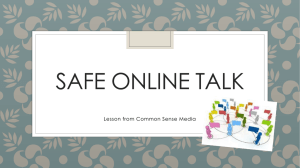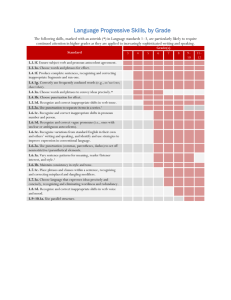The Teacher`s Guide To Keeping Students Safe Online
advertisement
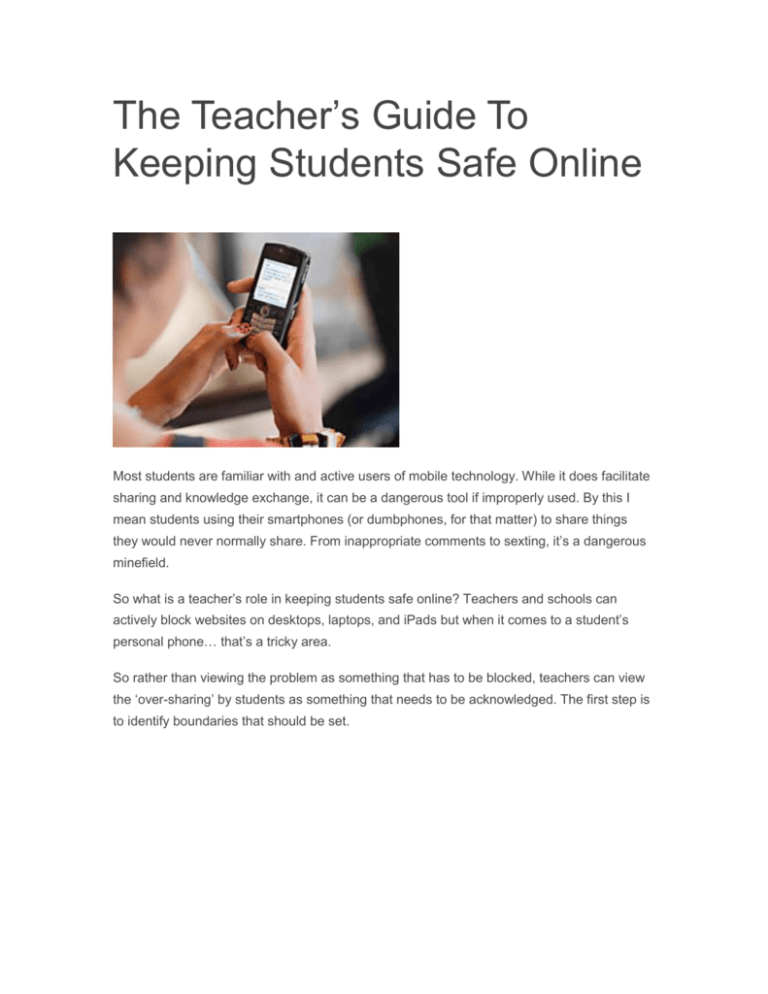
The Teacher’s Guide To Keeping Students Safe Online Most students are familiar with and active users of mobile technology. While it does facilitate sharing and knowledge exchange, it can be a dangerous tool if improperly used. By this I mean students using their smartphones (or dumbphones, for that matter) to share things they would never normally share. From inappropriate comments to sexting, it’s a dangerous minefield. So what is a teacher’s role in keeping students safe online? Teachers and schools can actively block websites on desktops, laptops, and iPads but when it comes to a student’s personal phone… that’s a tricky area. So rather than viewing the problem as something that has to be blocked, teachers can view the ‘over-sharing’ by students as something that needs to be acknowledged. The first step is to identify boundaries that should be set. Setting Boundaries Knowing when and where to draw the line according to your own personal comfort levels and ethics is a constant struggle for human beings, especially adolescents. Peer pressure is often the stressor that influences teens to overstep their boundaries to engage in regretful behavior. As teachers, we need to give students the intellectual and emotional tools to make the right decisions. What can teachers do? Help students set personal boundaries. Walk your students through hypothetical situations and ask them to set their boundaries and tolerance levels. They can’t defend their boundaries unless they know where they stand. For example, “A student asks you to text an inappropriate picture of yourself. What are your boundaries?” Some introspection now can save a lot of pain and angst later on. Bring personal boundaries into the open. Have students talk openly to their friends about their boundaries before there’s a time to test them. Teach students that true friends will always respect their boundaries. It’s okay to share concerns. Let students know if they are concerned about a friend’s health and safety, they need to speak to a trusted adult. Ask students to sign a “no-judgment” pledge for the classroom. Make the classroom a zone where they can relate what makes them uncomfortable without anyone laughing or holding grudges against them. Then ask your classes to talk about times they’ve felt pressured and uncomfortable. When you talk to your students about boundaries, frame the discussion as a life skill. Don’t make it about drugs, inappropriate internet use, etc. It’s a much broader issue tied into innate self-confidence. Now that we’ve discussed boundaries, let’s move into specific strategies to help kids deal with some common internet-related issues. Sexting The vast majority of teens have cell phones and the age at which they receive phones is getting younger and younger. This huge growth has spurred texting as the communication format of choice for teens. Combine this with expanding smartphone usage and teenage hormonal development; a perfect storm called sexting emerges. What is sexting? This is an unofficial term for sending nude or nearly nude images via text messaging. It is an illegal activity when it involves children under eighteen and violates most states’ sexual offender laws. However, many states are downgrading the offense since some teens have been convicted of laws usually reserved for serious criminals. Statistics show one out of six teenagers have received a sext message and four percent have sent messages themselves. It is thought the number is quite a bit higher since teens are reluctant to answer this question truthfully. More alarming is that a majority of students think sexting is “no big deal.” Why would teens send inappropriate pictures of themselves? Three scenarios are typical. Younger teens tend to send sext messages instead of actual physical contact. This can and does happen, even in middle school. Some students choose to send these messages to test the water before starting a more serious relationship. Finally, some students choose to engage in this behavior as part of romantic interactions. What can teachers do? Be aware that sexting is prevalent in middle and high schools. Be attentive to student discussions that might mention inappropriate texts and be prepared. Ask your principal now what the school policy is if you learn of a sexting situation. Warn students of the unintended audience. When interviewed about sexting, students tell of one scenario that happens over and over again. A student is convinced to send an inappropriate picture of him/herself to a boy/girlfriend. They have a fight or breakup and the image is sent to everyone in the school. This is absolutely devastating to a teenager and your students will most likely know someone this has happened to. Tell your students, “If you are going to text an inappropriate picture, you are sending it to the whole school.” Teach students how texts work. Believe it or not, many people believe texts fly magically through the air from phone to phone. They don’t! Students need to know that messages go through a computer system where all of the information is stored permanently. You can demonstrate this with a copy machine (or pretend a box is a copy machine). Have one student on one side and another student on the other. Give them both paper and pens. Now have them write a message on the paper for the other person. After they write a message, they have to give it to you first. You copy it (or pretend to copy it…just make sure you keep a piece of paper to represent each message) and hand it to the other student. You say, “Thanks, I’ll just copy this message, keep it forever and pass it along to the recipient.” Then, ask your students to “delete” a message by throwing the paper away. You still have permanent copies! Smartphone apps exist that allow people to text outside of the normal SMS cell phone network; therefore, saving texting fees. The concept is the same except instead of your data being copied and saved on the cell phone company’s servers, they are saved on the app server’s company. Teach students about image permanence and accessibility. People really don’t like to hear this…everything we do digitally is saved forever in a database and is most likely backed up in several locations throughout the world. Students think this is boring until you explain that actual people manage those databases and the information, including images, can be accessed. So, the image sent to another student is probably being viewed by a database manager in some other part of the world. Share your state laws with students. Students are often shocked when they find out they can be permanently labeled as sex offenders by sending an inappropriate picture of themselves. Also, law enforcement agencies can subpoena data and get access to all of a student’s texts and images. Discuss alternatives with your students. Have discussions and role-plays with students about what to say when solicited for an inappropriate picture. Having a solid, ready response such as, “I have too much respect for myself to do that and if you have respect for me, you won’t ask again,” can be vital to avoid being pressured into a regretful situation. Encourage parents to be proactive. Parents are usually very uncomfortable with the subject of sexting and want to ignore it. Talk to parents at school events and encourage them to tell their children this type of behavior is not acceptable. Sure, some students will ignore their parents or even rebel; however, many are yearning for guidance. Statistics on teen drug use show teens that have been told repeatedly by their parents that drugs are unacceptable have a much lower drug use rate. The same can be true for sexting. Develop a school-wide awareness campaign. For example, create an “If you wouldn’t send it to Grandma, don’t send it” campaign. Get your drama and art departments involved to create posters and skits. Picture a poster with a very shocked grandma looking at her phone! Inappropriate online material We all know inappropriate content is prevalent on the internet. As teachers in technology-rich learning environments, instances of this content are likely to occur even with internet filtering. This can be accidental or deliberate but planning ahead can help you be prepared to handle the situation. What can teachers do? Encourage appropriate use. It’s easy to focus on the negative aspects of internet usage, but you’ll have better results if you focus on the positive by encouraging appropriate use instead. If your students know, in no uncertain terms, what is and is not acceptable, everyone is on the same digital page. Teach students what to do if they accidently navigate to inappropriate content. The school district has filters in place to protect students from inappropriate content. However, these filters are not 100 percent effective. Teach students if they accidentally access something inappropriate, close the window, close your laptop and tell the teacher. As a teacher, don’t overreact. Explain that it is unfortunate that this type of content exists and move on. Be aware of school procedures for deliberate access to inappropriate content. Make sure you and your students know the acceptable use policies and consequences for unacceptable behavior. If a student chooses to ignore these policies and accesses inappropriate content, don’t overreact and be ready to follow the policy exactly. Inform students how data is stored when they surf the internet. Many students believe that search history is only stored on the computer they are using. If you delete the browsing history, the information is gone. In fact, everything we do on the internet, every search, every image we view, is tracked and stored forever on servers worldwide. It can never be deleted and could be accessed. Students do not need to be fearful of this fact; however, they need to be aware. Bring parents into the conversation. Responsible use of the internet is not just for school hours and week days. Parents and caregivers need to take responsibility for talking about these challenges in the home, too. Communicate with parents at events such as “digital Safety Night” and through school newsletters. Encourage them to set clear expectations for appropriate internet use from their children. Parents have expended a great deal of energy into teaching their children to “do the right thing,” to be honest, respectful and kind. Encourage parents to extend those values into the digital world. Learn more To learn more, explore these resources: Technology for Learning: A Guidebook for Change on the Digital Learning Environments site is loaded with great information for teaching the digital generation. Chapter three has excellent digital safety tips. Pew Internet & American Life Project is an excellent resource to discover the latest digital life statistics. Digital citizenship information can be found in the educators’ section of the ikeepsafe website. A couple of good books include Digital Citizenship in Schools by Mike Ribble and Gerald Baily and Raising a Digital Child by Mike Ribble. Conclusion There’s no doubt that sexting and other inappropriate content are uncomfortable topics— both for yourself and your students. However, developing a plan to address the digital birds and bees will provide the tools for students to navigate these difficult issues. Online Article can be found at: http://www.edudemic.com/guides/the-teachers-guide-tokeeping-students-safe-online/

